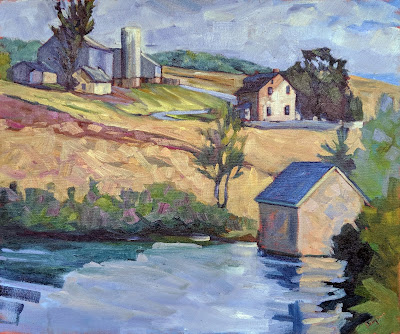In the end my paintings ended up mostly like me.
 |
| Home farm, by Carol L. Douglas |
On Monday, I wrote about my WWCD experience, where I tried to channel Colin Page but ended up painting like a Fauve. I continued similar experiments all week, channeling different masters each day. In fact, the ‘What Would So-and-So’ riff was embedded so deeply that I made up one based on Kirk Larson: “WWKD? Never turn down a free bottle of water.”
Yesterday’s painting started off as riff on Paul Gauguin, whose Yellow Christ hangs in the Albright-Knox Art Gallery in my hometown of Buffalo. That made it a seminal influence on my young brain.
 |
| Swiss Chard and red umbrella, by Carol L. Douglas |
I might have started with his color palette, but by the time I finished, the painting was pretty clearly my own. Perhaps that’s because brushwork and spatial design are more deeply embedded than color, which is relatively easy to manipulate. Or, it may be that I was concentrating on color first.
Why did I set out to do this? I had a conversation with Ken DeWaard this summer about trends in painting, particularly about high-key painting and whether an old dog like me can learn new tricks. (Since Ken just took the top prize at Cape Ann Plein Air, he doesn’t need to think about it.) I’ve been teaching about color harmonies, which put it in my mind. Also, it was a way to amp up my energy to finish the season well.
 |
| Marshaltown Inn, by Carol L. Douglas |
But other than that, I had no great intellectual pretensions; it was a whim and I followed it. That’s one of the joys of being an artist; you don’t have to clear your brainstorm with a committee.
It was a valuable exercise, one that I’m going to subject my students to at the first opportunity. But it takes months for the results of a class or workshop to insinuate themselves into one’s painting style (which is one reason that people who only paint in class seldom make great progress). I won’t be able to tell you how it benefitted me until much later.
 |
| The Radnor Hunt, by Carol L.Douglas |
Meanwhile, we’re done painting for Plein Air Brandywine Valley, and have a free morning before the opening reception. There are five painters here from Maine, and four of us are heading up to the Navy Shipyard in Philadelphia to paint boats. After that, we’ll get into the serious business of selling, but it’s our reward for working so hard.




